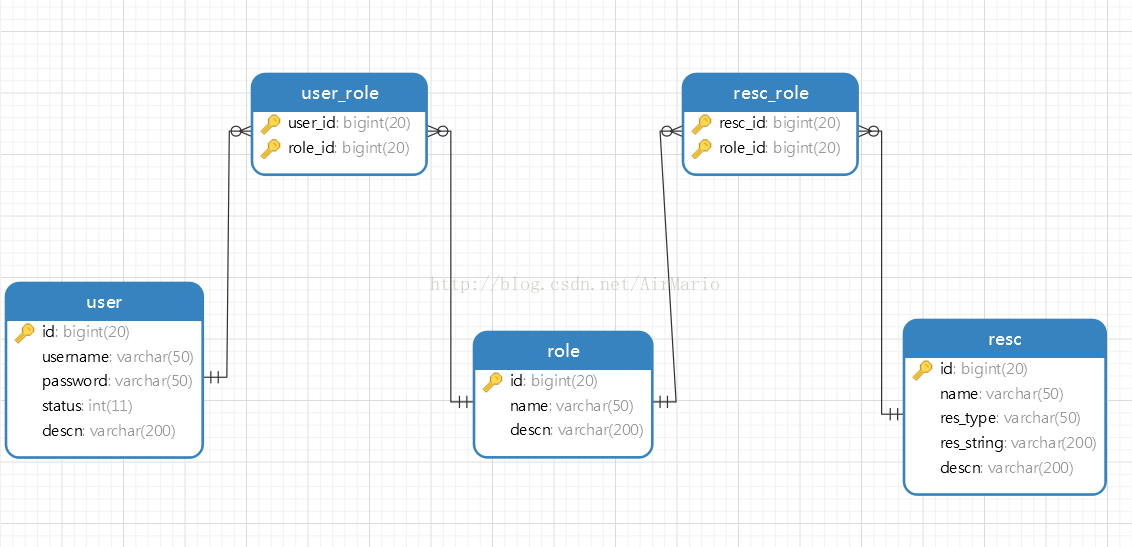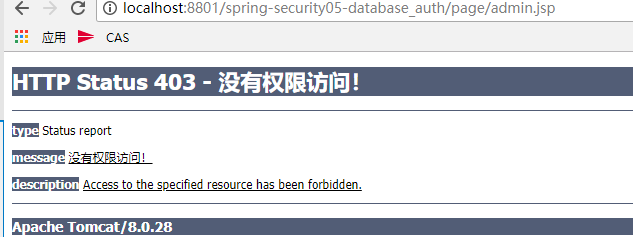【Spring Security】五、自定义过滤器
在之前的几篇security教程中,资源和所对应的权限都是在xml中进行配置的,也就在http标签中配置intercept-url,试想要是配置的对象不多,那还好,但是平常实际开发中都往往是非常多的资源和权限对应,而且写在配置文件里面写改起来还得该源码配置文件,这显然是不好的。因此接下来,将用数据库管理资源和权限的对应关系。数据库还是接着之前的,用mysql数据库,因此也不用另外引入额外的jar包。
一、数据库表的设计


DROP TABLE IF EXISTS `resc`; CREATE TABLE `resc` ( `id` ) ', `name` ) DEFAULT NULL, `res_type` ) DEFAULT NULL, `res_string` ) DEFAULT NULL, `descn` ) DEFAULT NULL, PRIMARY KEY (`id`) ) ENGINE=InnoDB DEFAULT CHARSET=utf8; -- ---------------------------- -- Records of resc -- ---------------------------- , '', 'URL', '/page/admin.jsp', '管理员页面'); , '', 'URL', '/page/user.jsp', '用户页面'); , null, 'URL', '/page/test.jsp', '测试页面'); -- ---------------------------- -- Table structure for resc_role -- ---------------------------- DROP TABLE IF EXISTS `resc_role`; CREATE TABLE `resc_role` ( `resc_id` ) ', `role_id` ) ', PRIMARY KEY (`resc_id`,`role_id`), KEY `fk_resc_role_role` (`role_id`), CONSTRAINT `fk_resc_role_role` FOREIGN KEY (`role_id`) REFERENCES `role` (`id`), CONSTRAINT `fk_resc_role_resc` FOREIGN KEY (`resc_id`) REFERENCES `resc` (`id`) ) ENGINE=InnoDB DEFAULT CHARSET=utf8; -- ---------------------------- -- Records of resc_role -- ---------------------------- , ); , ); , ); , ); -- ---------------------------- -- Table structure for role -- ---------------------------- DROP TABLE IF EXISTS `role`; CREATE TABLE `role` ( `id` ) ', `name` ) DEFAULT NULL, `descn` ) DEFAULT NULL, PRIMARY KEY (`id`) ) ENGINE=InnoDB DEFAULT CHARSET=utf8; -- ---------------------------- -- Records of role -- ---------------------------- , 'ROLE_ADMIN', '管理员角色'); , 'ROLE_USER', '用户角色'); , 'ROLE_TEST', '测试角色'); -- ---------------------------- -- Table structure for t_c3p0 -- ---------------------------- DROP TABLE IF EXISTS `t_c3p0`; CREATE TABLE `t_c3p0` ( `a` ) DEFAULT NULL ) ENGINE=InnoDB DEFAULT CHARSET=utf8; -- ---------------------------- -- Records of t_c3p0 -- ---------------------------- -- ---------------------------- -- Table structure for user -- ---------------------------- DROP TABLE IF EXISTS `user`; CREATE TABLE `user` ( `id` ) ', `username` ) DEFAULT NULL, `password` ) DEFAULT NULL, `status` ) DEFAULT NULL, `descn` ) DEFAULT NULL, PRIMARY KEY (`id`) ) ENGINE=InnoDB DEFAULT CHARSET=utf8; -- ---------------------------- -- Records of user -- ---------------------------- , , '管理员'); , , '用户'); , , '测试'); -- ---------------------------- -- Table structure for user_role -- ---------------------------- DROP TABLE IF EXISTS `user_role`; CREATE TABLE `user_role` ( `) ', `role_id` ) ', PRIMARY KEY (`user_id`,`role_id`), KEY `fk_user_role_role` (`role_id`), CONSTRAINT `fk_user_role_role` FOREIGN KEY (`role_id`) REFERENCES `role` (`id`), CONSTRAINT `fk_user_role_user` FOREIGN KEY (`user_id`) REFERENCES `user` (`id`) ) ENGINE=InnoDB DEFAULT CHARSET=utf8; -- ---------------------------- -- Records of user_role -- ---------------------------- , ); , ); , ); , );
二、实现从数据库中读取资源信息
Spring Security需要的数据无非就是pattern和access类似键值对的数据,就像配置文件中写的那样:
<intercept-url pattern="/login.jsp" access="IS_AUTHENTICATED_ANONYMOUSLY" />1 <intercept-url pattern="/admin.jsp" access="ROLE_ADMIN" /> <intercept-url pattern="/**" access="ROLE_USER" />
其实当项目启动时,Spring Security所做的就是在系统初始化时,将以上XML中的信息转换为特定的数据格式,而框架中其他组件可以利用这些特定格式的数据,用于控制之后的验证操作。现在我们将这些信息存储在数据库中,因此就要想办法从数据库中查询这些数据,所以根据security数据的需要,只需要如下sql语句就可以:
select re.res_string,r.name from role r,resc re,resc_role rr where r.id=rr.role_id and re.id=rr.resc_id
在数据中执行这条语句做测试,得到如下结果:

这样的格式正是security所需要的数据。
三 构建一个数据库的操作的类
package com.sunny.auth;
import java.sql.ResultSet;
import java.sql.SQLException;
import java.util.ArrayList;
import java.util.Collection;
import java.util.LinkedHashMap;
import java.util.List;
import javax.sql.DataSource;
import org.springframework.jdbc.core.support.JdbcDaoSupport;
import org.springframework.jdbc.object.MappingSqlQuery;
import org.springframework.security.access.ConfigAttribute;
import org.springframework.security.access.SecurityConfig;
import org.springframework.security.web.util.AntPathRequestMatcher;
import org.springframework.security.web.util.RequestMatcher;
public class JdbcRequestMapBulider extends JdbcDaoSupport{
//查询资源和权限关系的sql语句
private String resourceQuery = "";
//查询资源
@SuppressWarnings("unchecked")
public List<Resource> findResources() {
ResourceMapping resourceMapping = new ResourceMapping(getDataSource(), resourceQuery);
return resourceMapping.execute();
}
//拼接RequestMap
public LinkedHashMap<RequestMatcher, Collection<ConfigAttribute>> buildRequestMap() {
LinkedHashMap<RequestMatcher, Collection<ConfigAttribute>> requestMap = new LinkedHashMap<>();
List<Resource> resourceList = this.findResources();
for (Resource resource : resourceList) {
RequestMatcher requestMatcher = this.getRequestMatcher(resource.getUrl());
List<ConfigAttribute> list = new ArrayList<ConfigAttribute>();
list.add(new SecurityConfig(resource.getRole()));
requestMap.put(requestMatcher, list);
}
return requestMap;
}
//通过一个字符串地址构建一个AntPathRequestMatcher对象
protected RequestMatcher getRequestMatcher(String url) {
return new AntPathRequestMatcher(url);
}
public String getResourceQuery() {
return resourceQuery;
}
public void setResourceQuery(String resourceQuery) {
this.resourceQuery = resourceQuery;
}
/**
* 内部类,用于封装访问地址和权限
* @ClassName: Resource
* @Description: TODO(这里用一句话描述这个类的作用)
* @author Sunny
* @date 2018年7月4日 下午2:42:59
*
*/
private class Resource {
private String url;//资源访问的地址
private String role;//所需要的权限
public Resource(String url, String role) {
this.url = url;
this.role = role;
}
public String getUrl() {
return url;
}
public String getRole() {
return role;
}
}
@SuppressWarnings("rawtypes")
private class ResourceMapping extends MappingSqlQuery {
protected ResourceMapping(DataSource dataSource, String resourceQuery) {
super(dataSource, resourceQuery);
compile();
}
//对结果集进行封装处理
protected Object mapRow(ResultSet rs, int rownum) throws SQLException {
String url = rs.getString(1);
String role = rs.getString(2);
Resource resource = new Resource(url, role);
return resource;
}
}
}
说明:
- resourceQuery是查询数据的sql语句,该属性在配置bean的时候传入即可。
- 内部创建了一个resource来封装数据。
- getRequestMatcher方法就是用来创建RequestMatcher对象的
- buildRequestMap方法用来最后拼接成LinkedHashMap<RequestMatcher, Collection<ConfigAttribute>>供security使用。
四、替换原有功能的切入点
在将这部之前,先得了解大概下security的运行过程,security实现控制的功能其实就是通过一系列的拦截器来实现的,当用户登陆的时候,会被AuthenticationProcessingFilter拦截,调用AuthenticationManager的实现类,同时AuthenticationManager会调用ProviderManager来获取用户验证信息,其中不同的Provider调用的服务不同,因为这些信息可以是在数据库上,可以是在LDAP(轻量目录访问协议)服务器上,可以是xml配置文件上等,这个例子中是数据库;如果验证通过后会将用户的权限信息放到spring的全局缓存SecurityContextHolder中,以备后面访问资源时使用。当访问资源,访问url时,会通过AbstractSecurityInterceptor拦截器拦截,其中会调用FilterInvocationSecurityMetadataSource的方法来获取被拦截url所需的全部权限,其中FilterInvocationSecurityMetadataSource的常用的实现类为DefaultFilterInvocationSecurityMetadataSource,这个类中有个很关键的东西就是requestMap,也就是我们上面所得到的数据,在调用授权管理器AccessDecisionManager,这个授权管理器会通过spring的全局缓存SecurityContextHolder获取用户的权限信息,还会获取被拦截的url和被拦截url所需的全部权限,然后根据所配的策略,如果权限足够,则返回,权限不够则报错并调用权限不足页面。
根据源码debug跟踪得出,其实资源权限关系就放在DefaultFilterInvocationSecurityMetadataSource的requestMap,中的,这个requestMap就是我们JdbcRequestMapBulider.buildRequestMap()方法所需要的数据类型,因此就想到了我们自定义一个类继承FilterInvocationSecurityMetadataSource接口,将数据查出的数据放到requestMap中去。制定类MyFilterInvocationSecurityMetadataSource继承FilterInvocationSecurityMetadataSource和InitializingBean接口。
package com.sunny.auth;
import java.util.Collection;
import java.util.HashSet;
import java.util.List;
import java.util.Map;
import java.util.Set;
import javax.servlet.http.HttpServletRequest;
import org.springframework.beans.factory.InitializingBean;
import org.springframework.security.access.ConfigAttribute;
import org.springframework.security.web.FilterInvocation;
import org.springframework.security.web.access.intercept.FilterInvocationSecurityMetadataSource;
import org.springframework.security.web.util.RequestMatcher;
public class MyFilterInvocationSecurityMetadataSource implements FilterInvocationSecurityMetadataSource, InitializingBean{
private final static List<ConfigAttribute> NULL_CONFIG_ATTRIBUTE = null;
// 资源权限集合
private Map<RequestMatcher, Collection<ConfigAttribute>> requestMap;
//查找数据库权限和资源关系
private JdbcRequestMapBulider builder;
/*
* 更具访问资源的地址查找所需要的权限
*/
@Override
public Collection<ConfigAttribute> getAttributes(Object object) throws IllegalArgumentException {
final HttpServletRequest request = ((FilterInvocation) object).getRequest();
Collection<ConfigAttribute> attrs = NULL_CONFIG_ATTRIBUTE;
for (Map.Entry<RequestMatcher, Collection<ConfigAttribute>> entry : requestMap.entrySet()) {
if (entry.getKey().matches(request)) {
attrs = entry.getValue();
break;
}
}
return attrs;
}
/*
* 获取所有的权限
*/
@Override
public Collection<ConfigAttribute> getAllConfigAttributes() {
Set<ConfigAttribute> allAttributes = new HashSet<ConfigAttribute>();
for (Map.Entry<RequestMatcher, Collection<ConfigAttribute>> entry : requestMap.entrySet()) {
allAttributes.addAll(entry.getValue());
}
System.out.println("拥有权限:"+allAttributes.toString());
return allAttributes;
}
@Override
public boolean supports(Class<?> clazz) {
return FilterInvocation.class.isAssignableFrom(clazz);
}
//绑定requestMap
protected Map<RequestMatcher, Collection<ConfigAttribute>> bindRequestMap() {
return builder.buildRequestMap();
}
@Override
public void afterPropertiesSet() throws Exception {
this.requestMap = this.bindRequestMap();
}
public void refreshResuorceMap() {
this.requestMap = this.bindRequestMap();
}
/******************* GET & SET *******************************/
public JdbcRequestMapBulider getBuilder() {
return builder;
}
public void setBuilder(JdbcRequestMapBulider builder) {
this.builder = builder;
}
}
说明:
- requestMap这个属性就是用来存放资源权限的集合
- builder为JdbcRequestMapBulider类型,用来查找数据库权限和资源关系
- 其他的代码中都有详细的注释
五、配置文件
spring-dataSource.xml保持不变
<?xml version="1.0" encoding="UTF-8"?>
<beans:beans xmlns="http://www.springframework.org/schema/security"
xmlns:beans="http://www.springframework.org/schema/beans" xmlns:xsi="http://www.w3.org/2001/XMLSchema-instance"
xsi:schemaLocation="http://www.springframework.org/schema/beans
http://www.springframework.org/schema/beans/spring-beans-3.0.xsd
http://www.springframework.org/schema/context
http://www.springframework.org/schema/context/spring-context-3.1.xsd
http://www.springframework.org/schema/tx
http://www.springframework.org/schema/tx/spring-tx-3.0.xsd
http://www.springframework.org/schema/security
http://www.springframework.org/schema/security/spring-security.xsd">
<!-- 数据源 -->
<beans:bean id="dataSource" class="com.mchange.v2.c3p0.ComboPooledDataSource" destroy-method="close">
<!-- 此为c3p0在spring中直接配置datasource c3p0是一个开源的JDBC连接池 -->
<beans:property name="driverClass" value="com.mysql.jdbc.Driver" />
<beans:property name="jdbcUrl" value="jdbc:mysql://localhost:3306/springsecurity?useUnicode=true&characterEncoding=UTF-8" />
<beans:property name="user" value="root" />
<beans:property name="password" value="" />
<beans:property name="maxPoolSize" value="50"></beans:property>
<beans:property name="minPoolSize" value="10"></beans:property>
<beans:property name="initialPoolSize" value="10"></beans:property>
<beans:property name="maxIdleTime" value="25000"></beans:property>
<beans:property name="acquireIncrement" value="1"></beans:property>
<beans:property name="acquireRetryAttempts" value="30"></beans:property>
<beans:property name="acquireRetryDelay" value="1000"></beans:property>
<beans:property name="testConnectionOnCheckin" value="true"></beans:property>
<beans:property name="idleConnectionTestPeriod" value="18000"></beans:property>
<beans:property name="checkoutTimeout" value="5000"></beans:property>
<beans:property name="automaticTestTable" value="t_c3p0"></beans:property>
</beans:bean>
</beans:beans>
spring-context.xml修改如下
<?xml version="1.0" encoding="UTF-8"?>
<beans:beans xmlns="http://www.springframework.org/schema/security"
xmlns:beans="http://www.springframework.org/schema/beans" xmlns:xsi="http://www.w3.org/2001/XMLSchema-instance"
xsi:schemaLocation="http://www.springframework.org/schema/beans
http://www.springframework.org/schema/beans/spring-beans-3.0.xsd
http://www.springframework.org/schema/context
http://www.springframework.org/schema/context/spring-context-3.1.xsd
http://www.springframework.org/schema/tx
http://www.springframework.org/schema/tx/spring-tx-3.0.xsd
http://www.springframework.org/schema/security
http://www.springframework.org/schema/security/spring-security.xsd">
<!-- 不需要访问权限 -->
<http pattern="/page/login.jsp" security="none"></http>
<http auto-config="false">
<form-login login-page="/page/login.jsp" default-target-url="/page/admin.jsp" authentication-failure-url="/page/login.jsp?error=true" />
<logout invalidate-session="true" logout-success-url="/page/login.jsp" logout-url="/j_spring_security_logout" />
<!-- 通过配置custom-filter来增加过滤器,before="FILTER_SECURITY_INTERCEPTOR"表示在SpringSecurity默认的过滤器之前执行。 -->
<custom-filter ref="filterSecurityInterceptor" before="FILTER_SECURITY_INTERCEPTOR" />
</http>
<!-- 认证过滤器 -->
<beans:bean id="filterSecurityInterceptor" class="org.springframework.security.web.access.intercept.FilterSecurityInterceptor">
<!-- 用户拥有的权限 -->
<beans:property name="accessDecisionManager" ref="accessDecisionManager" />
<!-- 用户是否拥有所请求资源的权限 -->
<beans:property name="authenticationManager" ref="authenticationManager" />
<!-- 资源与权限对应关系 -->
<beans:property name="securityMetadataSource" ref="securityMetadataSource" />
</beans:bean>
<!-- 授权管理器 -->
<beans:bean id="accessDecisionManager" class="com.sunny.auth.MyAccessDecisionManager">
</beans:bean>
<!--自定义的切入点-->
<beans:bean id="securityMetadataSource" class="com.sunny.auth.MyFilterInvocationSecurityMetadataSource">
<beans:property name="builder" ref="builder"></beans:property>
</beans:bean>
<beans:bean id="builder" class="com.sunny.auth.JdbcRequestMapBulider">
<beans:property name="dataSource" ref="dataSource" />
<beans:property name="resourceQuery"
value="select re.res_string,r.name from role r,resc re,resc_role rr where
r.id=rr.role_id and re.id=rr.resc_id" />
</beans:bean>
<!--认证管理-->
<authentication-manager alias="authenticationManager">
<authentication-provider>
<jdbc-user-service data-source-ref="dataSource" id="usersService"
users-by-username-query="select username,password,status as enabled from user where username = ?"
authorities-by-username-query="select user.username,role.name from user,role,user_role
where user.id=user_role.user_id and
user_role.role_id=role.id and user.username=?" />
</authentication-provider>
</authentication-manager>
</beans:beans>
1.http中的custom-filter是特别要注意的,就是通过这个标签来增加过滤器的,其中before="FILTER_SECURITY_INTERCEPTOR"表示在SpringSecurity默认的过滤器之前执行。
package com.sunny.auth;
import java.util.Collection;
import java.util.Iterator;
import org.springframework.security.access.AccessDecisionManager;
import org.springframework.security.access.AccessDeniedException;
import org.springframework.security.access.ConfigAttribute;
import org.springframework.security.authentication.InsufficientAuthenticationException;
import org.springframework.security.core.Authentication;
import org.springframework.security.core.GrantedAuthority;
public class MyAccessDecisionManager implements AccessDecisionManager{
/*
* 该方法决定该权限是否有权限访问该资源,其实object就是一个资源的地址,authentication是当前用户的
* 对应权限,如果没登陆就为游客,登陆了就是该用户对应的权限
*/
@Override
public void decide(Authentication authentication, Object object, Collection<ConfigAttribute> configAttributes)
throws AccessDeniedException, InsufficientAuthenticationException {
if(configAttributes == null) {
return;
}
//所请求的资源拥有的权限(一个资源对多个权限)
Iterator<ConfigAttribute> iterator = configAttributes.iterator();
while(iterator.hasNext()) {
ConfigAttribute configAttribute = iterator.next();
//访问所请求资源所需要的权限
String needPermission = configAttribute.getAttribute();
System.out.println("访问"+object.toString()+"需要的权限是:" + needPermission);
//用户所拥有的权限authentication
Collection<? extends GrantedAuthority> authorities = authentication.getAuthorities();
for(GrantedAuthority ga : authorities) {
if(needPermission.equals(ga.getAuthority())) {
return;
}
}
}
//没有权限
throw new AccessDeniedException("没有权限访问! ");
}
@Override
public boolean supports(ConfigAttribute attribute) {
return true;
}
@Override
public boolean supports(Class<?> clazz) {
return true;
}
}
pom.xml中增加
<!-- j2ee -->
<dependency>
<groupId>javax.servlet</groupId>
<artifactId>javax.servlet-api</artifactId>
<version>3.1.0</version>
</dependency>
web.xml默认页面仍然是
五 结果
admin能访问的页面有admin.jsp、user.jsp;
user能访问的有user.jsp;
test能访问的有test.jsp。
如果权限不足,会提示“没有权限访问!”

【Spring Security】五、自定义过滤器的更多相关文章
- Spring Security(四) —— 核心过滤器源码分析
摘要: 原创出处 https://www.cnkirito.moe/spring-security-4/ 「老徐」欢迎转载,保留摘要,谢谢! 4 过滤器详解 前面的部分,我们关注了Spring Sec ...
- Spring Security 中的过滤器
本文基于 spring-security-core-5.1.1 和 tomcat-embed-core-9.0.12. Spring Security 的本质是一个过滤器链(filter chain) ...
- Spring Security(2):过滤器链(filter chain)的介绍
上一节中,主要讲了Spring Security认证和授权的核心组件及核心方法.但是,什么时候调用这些方法呢?答案就是Filter和AOP.Spring Security在我们进行用户认证以及授予权限 ...
- spring cloud gateway自定义过滤器
在API网关spring cloud gateway和负载均衡框架ribbon实战文章中,主要实现网关与负载均衡等基本功能,详见代码.本节内容将继续围绕此代码展开,主要讲解spring cloud g ...
- spring security 11种过滤器介绍
1.HttpSessionContextIntegrationFilter 位于过滤器顶端,第一个起作用的过滤器. 用途一,在执行其他过滤器之前,率先判断用户的session中是否已经存在一个Secu ...
- Spring Security :CsrfFilter过滤器
spring security框架提供的默认登录页面,会有一个name属性值为_csrf的隐藏域: 这是框架在用户访问登录页面之前就生成的,保存在内存中,当用户提交表单的时候会跟着一起提交: 然后会经 ...
- Spring Security(五) —— 动手实现一个 IP_Login
摘要: 原创出处 https://www.cnkirito.moe/spring-security-5/ 「老徐」欢迎转载,保留摘要,谢谢! 5 动手实现一个IP_Login 在开始这篇文章之前,我们 ...
- Spring Security:Servlet 过滤器(三)
3)Servlet 过滤器 Spring Security 过滤器链是一个非常复杂且灵活的引擎.Spring Security 的 Servlet 支持基于 Servlet 过滤器,因此通常首先了解过 ...
- Spring Security配置个过滤器也这么卷
以前胖哥带大家用Spring Security过滤器实现了验证码认证,今天我们来改良一下验证码认证的配置方式,更符合Spring Security的设计风格,也更加内卷. CaptchaAuthent ...
- spring security 3 自定义认证,授权示例
1,建一个web project,并导入所有需要的lib. 2,配置web.xml,使用Spring的机制装载: <?xml version="1.0" encoding=& ...
随机推荐
- report源码分析——宏的执行
uvm_info,uvm_error其实是对uvm_report_info,uvm_report_error的封装. 其中warning,error,fatal,macros默认都是定义为UVM_NO ...
- 回声状态网络(ESN)基础教程
http://jlearning.cn/2017/05/29/ESN-basic-tutorial/ 最近在看回声状态网络(Echo State Network)的内容,注意到中文搜索引擎搜不到关于有 ...
- 如何在Sitecore CMS中创建没有标准字段的模板
当创建一个模板,Sitecore的将默认为扩大“标准模板”,它位于/sitecore/templates/System/Templates. 如果您选择不扩展任何模板或从“基本模板”字段中删除标准模板 ...
- 准备dbcp2-2.1.1和pool2-2.4.2 、commons-dbcp-1.4jar包
下载地址:https://pan.baidu.com/s/1gtcW36Lz6Yt-j9WlTu31Pw
- linux文件系统的用户和权限管理
1. 为什么要有用户的概念? 多用户,多任务业务对系统资源的隔离产生需求 2. linux 用户的分类? 2.1. 管理员 拥有操作所有文件的权限 2.2. 普通用户 2.2.1. 普通登录用户 2. ...
- mark_save
class BookConfig(ModelStark): def edit(self, obj=None, is_header=False): if is_header: return " ...
- 设计模式之模板方法模式:实现可扩展性设计(Java示例)
概述 在实际开发中,常常会遇到一项基本功能需要支撑不同业务的情况.比如订单发货,有普通的整包发货,有分销单的发货,采购单的发货,有多商品的整包或拆包发货等.要想支持这些业务的发货,显然不能在一个通用流 ...
- Java并发编程:volatile关键字解析-转
Java并发编程:volatile关键字解析 转自海子:https://www.cnblogs.com/dayanjing/p/9954562.html volatile这个关键字可能很多朋友都听说过 ...
- 设计模式之Proxy(代理)(转)
理解并使用设计模式,能够培养我们良好的面向对象编程习惯,同时在实际应用中,可以如鱼得水,享受游刃有余的乐趣. Proxy是比较有用途的一种模式,而且变种较多,应用场合覆盖从小结构到整个系统的大结构,P ...
- AURO OtoSys IM100 vs Lonsdor K518ISE: which better?
Comparison: AURO OtoSys IM100 and Lonsdor K518ISE It’s aimed to help make a purchase of decent auto ...

